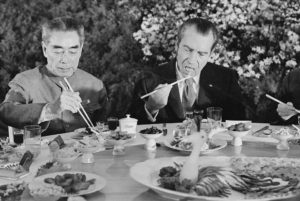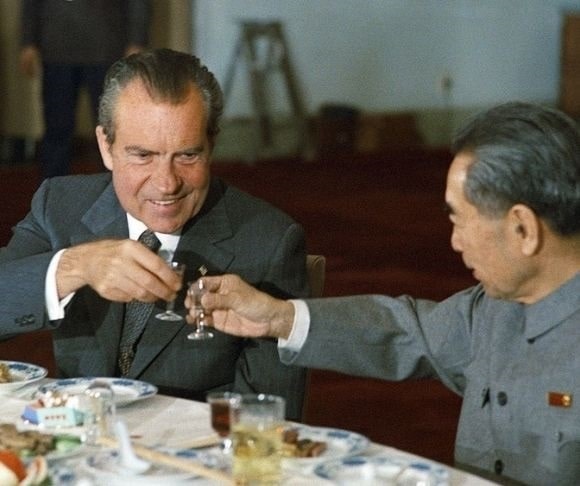What began as an olive branch extended to China has become a thorn in the side of U.S. national security. Between the establishment of the People’s Republic of China (PRC) in 1949 and President Richard Nixon’s 1972 visit, China existed in isolation from the United States, the most influential post-World War II nation. Henry Kissinger, Nixon’s national security advisor, met with Chinese Premier Zhou Enlai in July 1971 to prepare a visit from the U.S. president.

Zhou Enlai (L) and Richard Nixon (R) (Getty Images)
Underlying Nixon’s desire to reach out to China was a firm belief that ignoring the massive geography and large population was a fool’s errand. As early as 1967, in an article written for Foreign Affairs headlined “Asia After Viet Nam,” Nixon revealed his views regarding the future importance of the PRC. “We simply cannot afford to leave China forever outside the family of nations, there to nurture its fantasies, cherish its hates, and threaten its neighbors. There is no place on this small planet for a billion of its potentially most able people to live in angry isolation,” he wrote. Nixon could see the national security impact of the Asian behemoth.
Just before leaving for China, Nixon explained again the purpose for his upcoming trip to Beijing in a White House conversation. According to the transcript taken from the Nixon Presidential Library archives, the 37th president said:
“… when they [China] become a superpower, a nuclear superpower, uh, to be in a position that at that time, uh, we will have such relations with them that, uh, we, uh, can discuss differences and, and not inevitably have a clash. Now, also, no one can look at Asia, uh, and take 750 million Chinese out of it and say you can have any policy in the Pacific that will succeed in preventing war without having the Chinese a part of it.”
When Nixon returned from his China door-opening trip, he lamented that numerous reporters and pundits assumed because the Chinese Communist Party (CCP) had agreed to the visit and discussions with Beijing’s leadership had been friendly, relations with the PRC “would be a lot better.” But the president was a realist who knew the visit simply established a mutual understanding of each country’s world view. As to suddenly having a less dangerous planet, Nixon explained, “Not true at all.” The fact each of the leaders knew one another better, as he pointed out, “will reduce the possibility of miscalculation … And I hope that would be true of whoever happens to be sitting in this office in the future. That means that there will be talking and rather than … suspicion and miscalculation, which could lead to war.” Unfortunately, subsequent presidents “sitting in this office” in the White House, despite the rapprochement with the CCP created by Nixon, did not perceive the growing Chinese presence on the world’s stage with the appropriate alarm.
A warning came with Nixon’s peace overture to China, “if we do not find a way to, uh, despite our differences to have discussions, we are on a collision course years ahead.” Nixon had prescience with a caution that should have been heeded. Instead, all people knew was what the pundits had mistakenly believed, the U.S. and China were two countries with the same desires and shared goals for the future. That misperception has put America in economic and military peril.
 While U.S. presidents all too often saw the PRC as a partner in securing a more peaceful coexistence in the Pacific and as a vast market for American products and technology, China had different ideas. Beijing’s purpose was domination, regardless of how long it takes, not cooperation. As a result, for the last 50 years – with some exceptions – presidential administrations have been sanguine with the relationship between Washington and Beijing. No more so than when the U.S. agreed to the admission of the PRC into the World Trade Organization (WTO) as a “developing nation.”
While U.S. presidents all too often saw the PRC as a partner in securing a more peaceful coexistence in the Pacific and as a vast market for American products and technology, China had different ideas. Beijing’s purpose was domination, regardless of how long it takes, not cooperation. As a result, for the last 50 years – with some exceptions – presidential administrations have been sanguine with the relationship between Washington and Beijing. No more so than when the U.S. agreed to the admission of the PRC into the World Trade Organization (WTO) as a “developing nation.”
As Guy Taylor reported in the Washington Times, “China’s status as a ‘developing’ nation in the eyes of multinational institutions and agreements gives Beijing a range of benefits, including less strict carbon emission standards and softer trade rules, despite its emergence as an economic and military superpower challenging U.S. dominance in Asia and beyond.” The PRC is not shy about what its intentions are. In a National Review article published just last year, Manyin Li quotes a highly revered Chinese scholar, Jin Canrong, who explained publicly the Beijing government’s approved message. He said: “The task of this generation is to gain equal footing with the U.S. that of the next generation is to administer all other countries, the United States included.” The thought of China administering “all other countries” is a frightening U.S. national security challenge. Believe your enemy when it speaks.
If not checked, China is a threat now and a growing menace for the future. What started as a promising geopolitical strategy five decades ago has become what Nixon hoped to prevent: a China with the will and means to pose a real threat to America. But hope is not a strategy.
The views expressed are those of the author and not of any other affiliation.
~ Read more from Dave Patterson.




